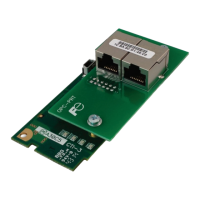Input: The Input Assembly is the collection of monitor data that is produced by the interface card
and is received as an input to the PLC. Its structure is defined by the Produced Data Configuration
as described in section
9.2.4. The Input Assembly Instance must be set to 150 when connecting to
the generic I/O assembly instances (or 70/71 when using the ODVA AC/DC drive profile), and the
size must be set to the number of 16-bit function codes that we wish to receive from the interface
card. For the purposes of this example, we are assuming that the default produced data word
configuration, with two relevant function codes (M14 and M09). We therefore set the Input Size to
2.
Output: The Output Assembly is the collection of command & configuration data that is sent as an
output from the PLC and consumed by the interface card. Its structure is defined by the Consumed
Data Configuration as described in section
9.2.4. The Output Assembly Instance must be set to
100 when connecting to the generic I/O assembly instances (or 20/21 when using the ODVA
AC/DC drive profile), and the size must be set to the number of 16-bit function codes that we wish
to send to the interface card. For the purposes of this example, we are assuming that the default
consumed data word configuration, with two relevant function codes (S06 and S05). W e therefore
set the Output Size to 2.
Configuration: The Configuration Assembly Instance is unused, and its instance number and
size are therefore irrelevant (you can just enter “1” and “0”, respectively).
When done, click “OK”.
5) You should now see the new module (named “ETHERNET-MODULE Interface_Card”) in the
1756-ENBT/A branch under the I/O Configuration in the controller organizer view. Right click on
this new module, choose “Properties”, and select the Connection tab. Refer to Figure 53.
Figure 53: Module Properties Connection Tab
Confirm the setting of the Requested Pack et Interval (RPI). The RPI defines the amount of time (in
milliseconds) between data exchanges across an I/O connection. The smallest RPI supported by
the interface card is 1ms. Click OK when done.
6) After adding the I/O Module to the configuration,
the full I/O Configuration tree should appear similar
to Figure 54.
7) Switch to online mode and download the project to
the PLC. Verify that the newly-added inverter is
available and operating correctly by observing any
indications shown on the inverter’s icon. When the
inverter’s icon is selected, its status and any
available error messages will be displayed in the
area below the project tree. Refer to Figure 55. Also confirm that the interface card’s “Network
Status” LED should be solid green, indicating an “online/connected” state.
Figure 54: I/O Configuration Tree

